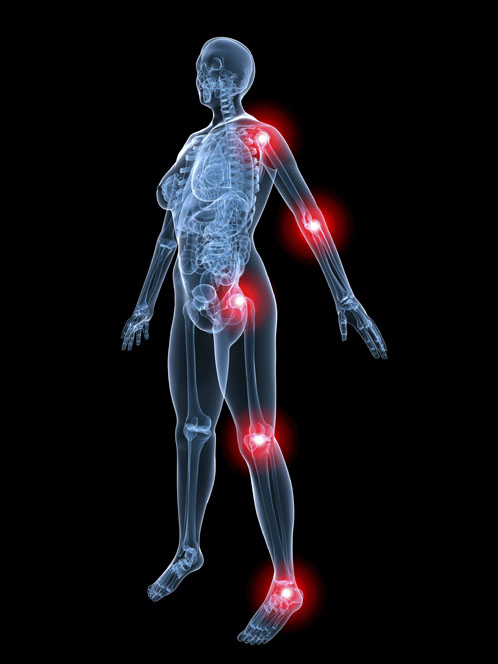The pandemic saw a seismic shift in consumer habits and activity levels. It was a period that had a profound and prolonged impact on the way people live, move and behave, and will likely affect both mobility and consumer health as a whole for many years to come.
More sedentary lifestyles caused by widespread lockdowns, for example, saw weight gain and joint stiffness for some — the result of reduced activity levels and gym closures.1 Conversely, others dedicated more time to getting healthier than ever before, working towards new physical and mental well-being goals.2
For the many consumers now keen to move on from the effects of the pandemic, pressing reset on their wellness is an essential first step to regaining a sense of empowerment and achieving their individual health goals.
By now, more consumers are aware of how to take care of their health and have a greater understanding of how joint health contributes to the bigger picture. This, together with an ever-growing selection of joint health solutions on the market, means there is an opportunity for consumers of all ages to reclaim their mobility and support their joint health for the long-term.
For brand and supplement producers, however, it’s a complex and dynamic market to navigate. Uncovering new science and innovations is key to unlocking novel formulation possibilities and, ultimately, helping brands to stand out and capture consumer attention.

Consumers want it all
It’s no surprise that joint degradation affects most people as they age. Joints are complex, finely tuned structures that undergo intense, repetitive physical activity throughout a lifetime, causing wear and tear.
According to a survey, 52% of US consumers older than 40 reported joint health concerns in recent months (proprietary Lonza survey: unpublished data). With the world’s population ageing, joint health will undoubtedly become an even greater health priority for many consumers in the years to come.
Although ageing has long been associated with joint health, it’s not just seniors who are interested in mobility solutions. They represent just one segment of the market. Joint health products are gaining popularity among people of all ages and fitness levels as they look to lead healthier, more active lives.
In the UK, for example, 26% of people are starting to exercise more than they were before the pandemic began.3 A recent report also found that “wellness” has become a top priority for 40% of the global population on average.4
Young athletes, weekend warriors and busy parents are among the new demographics who are putting their joint health first. For instance, with more disposable income than 10 years ago as they move up the career ladder, millennials are stepping up their purchasing power.
Research shows that millennial consumers doubled their monthly supplement spending since 2010 as they look to prioritise their long-term mobility and overall well-being.5
With more consumers bringing joint health to the fore, it is important that brands and producers recognise what this new generation of joint health consumers want from their supplement products and their purchasing behaviours.
Some, for example, want greater joint comfort, mobility, flexibility and range of motion, which can not only provide day-to-day comfort but support improved exercise performance for physically active consumers.6
What’s more, consumers want high quality, proven products; 82% of current US supplement users are interested in taking an effective joint health supplement. More broadly, supplement users want proof that a product works, but that must also be combined with convenience and an appealing sensory experience.
So how can supplement brands and producers meet these complex consumer needs and stand out against other supplements?
The right ingredient
For brands looking to make an impact, ingredient choice is key. The joint health space has evolved significantly in recent years, with continuous investment in research and development. From glucosamine and chondroitin, to methylsulfonylmethane (MSM) and, more recently, botanical ingredients, there’s a diverse range of joint health solutions on the market today.
However, many of these ingredients can fall short on convenience, requiring a high dose to be effective, whereas others do not offer the scientific proof of efficacy that consumers are looking for.

One ingredient attracting growing attention from nutraceutical manufacturers is collagen, with new product launches increasing by 30% between 2019 and 2020.7
Categorised into three types, each collagen grouping has its own set of characteristics. The primary protein in cartilage, type II collagen effectively supports joint health — with “undenatured” or “native” collagen being the most effective form.8,9
But it’s important to remember that not all collagen is created equal. Backed by human clinical studies, UC-II® undenatured type II collagen has a unique, proprietary manufacturing method that stimulates the body to build new joint cartilage.
Its small 40 mg daily dose opens up opportunities for innovative formulations to differentiate from other options on the market — whether as a single ingredient or in combination with either other joint health ingredients or those that support consumers’ broader health goals.
The extensive bank of scientific evidence behind UC-II undenatured type II also makes the ingredient an appealing option for brands. New research conducted by Lonza in younger populations found that supplementation with UC-II undenatured type II collagen offers important mobility benefits for this broader, as yet currently underrepresented, demographic.
The randomised, double-blind, placebo-controlled clinical study investigated the effects of a 40 mg daily dose of UC-II undenatured type II collagen in 96 active, healthy male and female subjects (20–55 years old) experiencing pain with physical activity during a 6-month period. In those older than 35, there was a statistically significant increase in knee joint flexion.10
This correlates to joints feeling 10 years younger, according to data from the Centers for Disease Control (CDC).11
The results also showed reduced joint discomfort after physical activity and significantly decreased knee discomfort when twisting/pivoting the knee, walking downstairs and walking on a flat surface (compared with a placebo at 180 days).12
Plus, participants taking UC-II undenatured type II collagen walked more than 1/4 mile (0.4 km) more per day compared with the placebo, indicating that this solution helps to make walking more comfortable and helps people to hit their daily step goals.13
Although previous studies have focused on UC-II undenatured type II collagen among older populations, these new insights highlight the benefits in younger populations of healthy subjects too. This presents a new opportunity for brands to turn cutting-edge science into real opportunities for the evolving joint health consumer.
Seizing the opportunity
Whatever their age or demographic, many consumers want to move more and are looking for solutions that support these increasingly active lifestyles — whether they’re going for a walk around the block or a fast-paced HIIT workout.
With consumer demand for joint health solutions booming alongside advancements in formulation technologies and new scientific research, producers can seize the opportunity to disrupt this growing category.
As the market diversifies, nutraceutical brands can stay at the forefront of joint health innovation, efficacy and convenience with Lonza’s UC-II undenatured type II collagen. The future of mobility is here. Are you ready to press reset?
References
- www.apa.org/news/press/releases/2021/03/march-weight-change.
- www.ihrsa.org/publications/the-covid-era-fitness-consumer/#.
- https://store. mintel.com/uk-healthy-lifestyles-market-report.
- www.mckinsey.com/industries/ consumer-packaged-goods/our-insights/sweating-for-the-fitness-consumer.
- Nutrition Business Journal, Condition Specific Report 2020 (2020).
- www.nmisolutions.com/syndicated-data/databases-overview/supplements-otc-rx-trends-us-and-global-databases/.
- Nutrition Business Journal, Condition Specific Report 2019 (2019).
- C.M. Bagi, et al., “Oral Administration of Undenatured Native Chicken Type II Collage (UC-II) Diminished Deterioration of Articular Cartilage in a Rat Model of Osteoarthritis (OA),” Osteoarthritis Cartilage 25(12), 2080–2090 (2017).
- O.B. Yaremenko, et al., “Efficacy, Tolerance and Influence on Cartilage Metabolism of Undenatured Collagen Type II UC-II (Mercana) in Knee OA,” PAIN, JOINTS, SPINE 11(3), 5–12 (2021).
- C. Schön, et al., “UC-II Undenatured Type II Collagen for Knee Joint Flexibility: A Multicenter, Randomized, Double-Blind, Placebo-Controlled Clinical Study,” J. Integr. Complement. Med. 28(6), 540–548 (2022).
- J.M. Soucie, et al., “Range of Motion Measurements: Reference Values and a Database for Comparison Studies,” Haemophilia 17(3), 500–507 (2011).
- K. Knaub, et al., “UC-II Undenatured Type II Collagen Reduces Knee Joint Discomfort and Improves Mobility in Healthy Subjects: A Randomized, Double-Blind, Placebo-Controlled Clinical Study,” J. Clin. Trials 12(1), 1000492 (2022).




